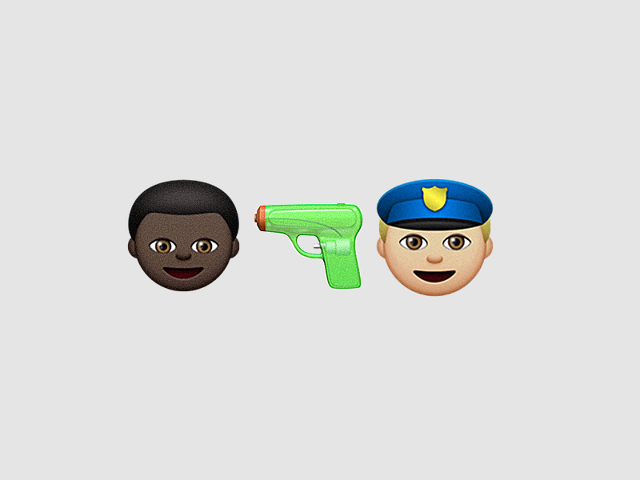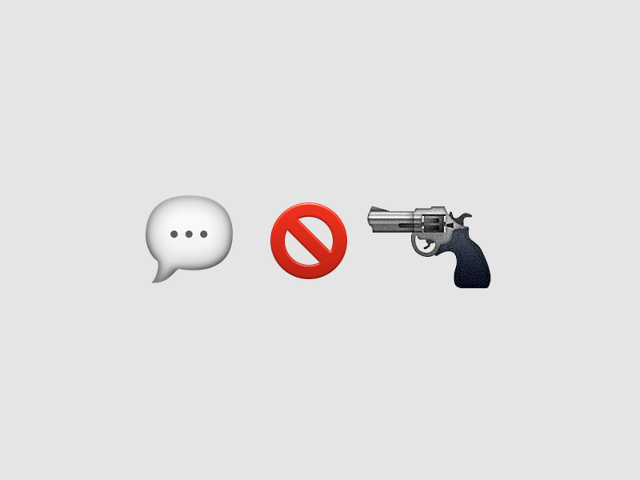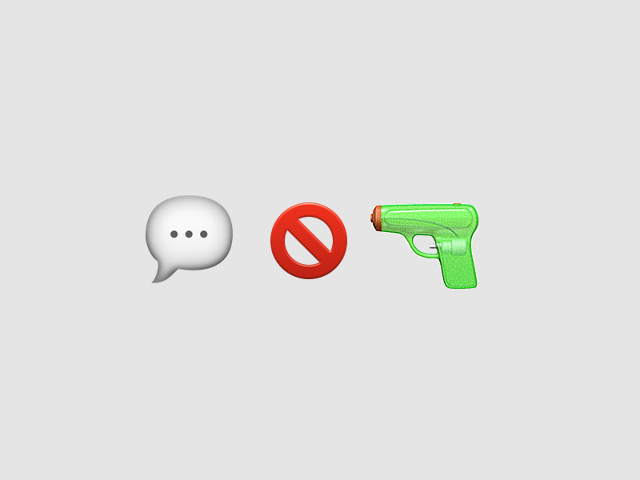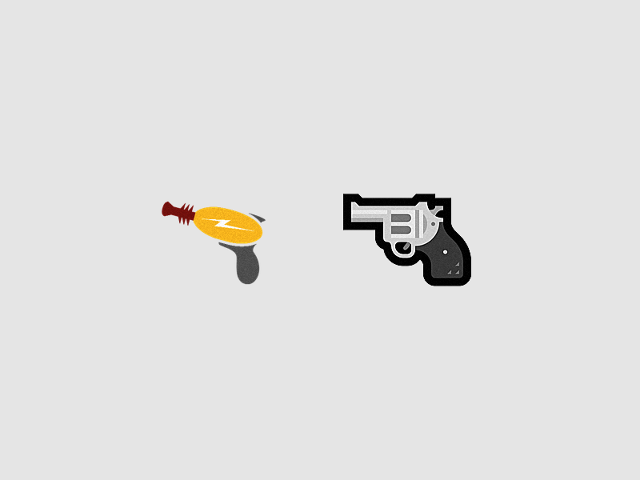By changing the meaning of a universal symbol, Apple's attempt to take a stand on gun control could have the opposite effect.
Last week, Apple made a small but significant update to the emoji set used in upcoming iOS 10 and macOS Sierra software updates. The company changed the handgun emoji, first added to the Unicode Standard in 2010, to a plastic squirt gun. Although yet to be confirmed by Apple itself, the change was seemingly made in response to a year-long campaign by gun control nonprofit New Yorkers Against Gun Violence (NYAGV) to get Apple to remove the gun emoji and "take a stand for stricter gun accessibility in America."
It was an odd move. Because of the way emoji works— each emoji is essentially a sticker that an operating system slaps on top of an otherwise unreadable UTF-16 character code—changing the pistol emoji to a water gun emoji retroactively censors the ideas of millions of people, many of whom—ironically—were using the pistol emoji to take a stand against serious social issues like relaxed gun control and police shootings. If Apple is serious about influencing the debate around gun control, there are smarter ways to effect change. Here's why.
First things first. Emoji aren't just an arbitrary collection of cartoon stickers on your smartphone. They reflect an industry standard, set by a group called the Unicode Consortium. This group defines what UTF-16 character code is assigned to which emoji. Because emoji are applied on a software platform level, every software maker's emoji look a bit different from each other. Even so, it's important for the meaning of an emoji to be the same across operating systems, so that a heart symbol sent from an iPhone doesn't display like a swastika on an Android phone. That's why the Unicode Standard suggests, in general terms, what every emoji should convey. Companies like Apple that join the Unicode Consortium therefore agree to not change the meaning of an emoji upon a whim: For emoji to work universally across both operating systems and language barriers, it's important that their designs adhere to what's laid out in the Standard.
So when we discuss Apple changing the design of the pistol emoji, we first need to ask ourselves what the Unicode Standard says it should look like. Is a water pistol a valid interpretation of the Consortium's guidance on what a pistol emoji should look like?
According to the Unicode Standard, the document that defines what an emoji should look like across all software and devices, the pistol emoji is meant to be a handgun or a revolver—specifically, one that can be used as a weapon, not a toy. Emojipedia, a resource put together by Unicode Emoji Subcommittee member Jeremy Burge, meanwhile, describes the emoji as a "a gun emoji, more precisely a pistol. A weapon that has potential to cause great harm. This type of firearm is commonly held by police officers." (Emphasis added).
The pistol emoji is often used in that context by Black Lives Matter supporters and others protesting police shootings, and—yes—on both sides of the gun control debate. (You can see a real-time tracker of all the tweets using the pistol emoji here.)
With the release of iOS 10 and macOS Sierra, Apple will essentially retcon the meaning of any tweet, every email, every Facebook status update that has ever used the pistol emoji on hundreds of millions of devices. Where the pistol emoji was once a symbol of death, murder, and oppression, it will be turned into something silly and frivolous, a child's plaything that could never harm anyone. Consider, for example, this string of symbols:


Right now, these three emoji covey the message of a police officer shooting an unarmed black man. After Apple changes the pistol design, anyone who has ever used that sequence will instead be talking about a police picnic water gun fight.
Or this:


"Say no to guns" now becomes "say no to Super Soakers."
When NYAGV originally pushed Apple to get rid of the gun emoji, they did so because they wanted Apple to send a message to Congress to enact mandatory background checks. "We ask that you stand with the American people and remove the gun emoji from all your products as a symbolic gesture to limit gun accessibility," they wrote in an open letter. "We understand taking the emoji out will not end gun violence, but this act will show Congress that gun-owning and non-owning Americans have come together to demand required background checks for ALL gun sales."
Even at the time, it was a rather bizarre request that didn't understand how emoji actually get created—software makers are not free to simply remove them, at least if they want to remain part of the Unicode Consortium. But it seems clear that Apple has at least taken the spirit of the request to heart, complying with it as much as it is capable of doing. They're sending a symbolic message about gun control through emoji. The problem, though, is that messing with the way that people communicate with one another isn't symbolic. It's deeply literal. Apple changing the pistol emoji to something less lethal screams: "We can all live in a world without guns!" But we don't live in a world without guns. So Apple's design change actually has the opposite effect of what it intended: it makes it less possible for people to express themselves about gun control, whether for or against it.
Compare this, now, to Microsoft's pivot in the opposite direction. As part of the Windows Anniversary Update released two weeks ago, Microsoft is also changing its emoji design. But while Windows used to boast a sci-fi ray gun for a pistol emoji—again, explicitly against the instructions for such a symbol used in the Unicode Standards—Microsoft will now use a realistic drawing of a police pistol, essentially bringing Windows back in line with the standard. What's most notable to me about the new Windows pistol emoji is its thick outline, almost as if Microsoft wanted to draw attention to the stark brutality of such a weapon, instead of whitewash it away. It's the equivalent of putting the word gun in bold, emphasizing the weapon's deadly nature. Microsoft's change of heart acknowledges that a gun is deadly serious. And it deserves to be talked about.

Some might argue that emoji aren't the proper medium for exploring serious social issues, like gun control. That's a classist position that ignores emoji's ability to express concepts universally across language barriers. People do take emoji seriously. Companies like Apple and Google know this and have made moves to create more diverse characters as a result.
Which is why Apple's move here is so head-scratching. The company has effectively changed the meaning of one of the most popular symbols on earth to mean the opposite of what it used to mean. And because of the way emoji work, that change doesn't just affect the use of that symbol in the future, but also the past. George Orwell could never have imagined a world in which emoji are as popular as they are, but he did write a book about one in which the meaning of words could be universally rewritten at the whim of powerful institutions. It was called 1984, and while it would be silly to say this issue is Big Brother serious, it does reveal a problem with the emoji standard as we know it: Companies shouldn't be able to rewrite our thoughts, just by changing a sticker.
If Apple really wants to bring the truly senseless number of firearm deaths in this country to an end, it should bring back the pistol emoji as it previously existed, then use its considerable political clout and cash pile to lobby Congress or donate to gun control groups. The debate over gun control isn't going to be won by giving people one less way to talk about it.